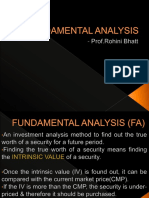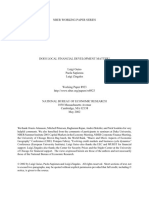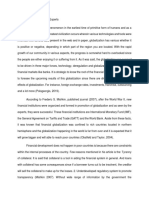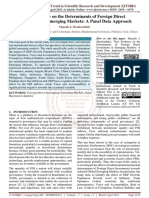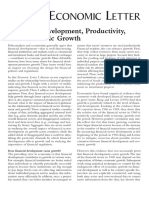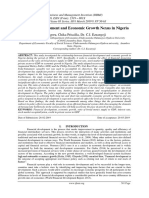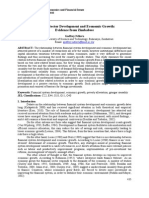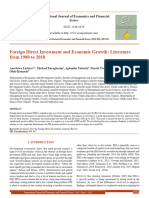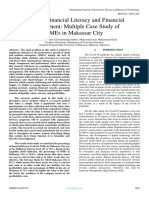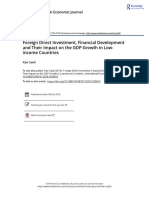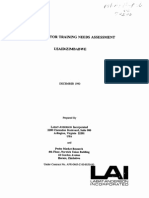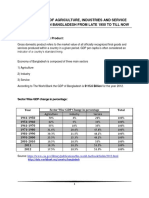Professional Documents
Culture Documents
Financial Liberalization and Economic
Copyright
Available Formats
Share this document
Did you find this document useful?
Is this content inappropriate?
Report this DocumentCopyright:
Available Formats
Financial Liberalization and Economic
Copyright:
Available Formats
Volume 5, Issue 4, April – 2020 International Journal of Innovative Science and Research Technology
ISSN No:-2456-2165
Financial Liberalization and Economic
Growth in Nigeria (1986-2018)
ILUGBUSI, Segun. B. AJALA, Rosemary B.
Department of Management and Entrepreneurship Department of Banking and Finance, The Federal
College of Social and Management Sciences, Afe Babalola Polytechnic Ado Ekiti, Ekiti-State
University, Ado-Ekiti.
AKINDEJOYE, John A. OGUNDELE, Abiodun
Department of Management and Entrepreneurship Department of Banking and Finance
College of Social and Management Sciences, Afe Babalola College of Social and Management Sciences, Afe Babalola
University, Ado-Ekiti University, Ado-Ekiti
Abstract:- Several studies have emerged since the work I. INTRODUCTION
of McKinnon and Shaw (1973) on the relationship
between financial liberalization and economic growth. The argument for financial liberalization was brought
However, there are still dearth of literature in respect to to the brim light by the seminal work of McKinnon (1973)
the proxies employed for financial liberalization. As a and Shaw (1973). These two scholars separately did a work
result, this study investigated the effect of financial on financial liberalization in relation to economic growth.
liberalization on economic growth in Nigeria covering a They expressed that when financial market is liberalized by
period of 33years spanning 1986 to 2018. Adopting eliminating series of impediments or restrictions economic
McKinnon and Shaw hypothesis as the theoretical growth would be enhanced. In their studies, they both
framework, economic growth was represented by gross found that, financial liberalization, through removal of
domestic product (GDP), financial liberalization was government intervention in regulating interest rate and
represented by prime lending rate, saving deposit rate, direction of credit positively and significantly impact
exchange rate, credit to private sector and ratio of economic growth. This implies that, financial liberalization
private investment to GDP. Data were sourced from policies increase savings, leads to a more efficient
CBN Statistical Bulletin and estimation done using auto allocation of resources, higher level of investment and
regressive distributed lag. The study found that, economic growth (Khazri & Djelassi 2011). Ever since
financial liberalization has long and short run then, there have been numerous replicas of studies either on
relationship with economic growth. Further findings country specific or cross countries on financial
also showed that prime lending rate had insignificant liberalization. However, there have been no consensus and
positive and credit to private sector had significant the research are still on going.
positive effects on economic growth. On the other hand,
savings deposit rate, exchange rate and ratio of private Despite the positive results found by the proponents,
investment to GDP have insignificant negative effects on financial liberalization has been criticized on the ground
economic growth. The study concluded that, financial that, it increases the risk of speculative attacks and
liberalization has significant positive effect on economic country’s exposure to international shocks and capital
growth with overriding effect from credit to private flight. For example, Gridlow (2001) as cited by Tswamuno,
sector. Therefore, the study recommended among Parde and Wunnava (2007) says that “Developing countries
others that, government through the Central Bank of in the 1980s and early 1990s had been led to believe that
Nigeria should review the saving deposit rate upward in foreign investment in the form of equities and bonds traded
order to encourage increase of domestic savings by on the local markets were more long term in nature than
surplus sector of the economy. More importantly, foreign bank lending they attracted in the 1970s. However,
policies that will encourage private sector investment huge flight of capital from the emerging markets at times in
should be looked into by government so as to further recent years has exploded that myth.” There was also
stimulate economic growth in Nigeria. argument that financial liberalization may increase the
incidence of financial crises (Baldacci, De Mello &
Keywords:- Financial Liberalization, Economic Growth, Inchauste Comboni, 2002). Further argument was that,
Credit To Private Sector, Prime Lending Rate. information asymmetries which are endemic to financial
markets and transactions in developing countries can be
detrimental to liberalization as and as such, it was
contended that, emerging markets do not have the
capability to assemble information relevant to financial
transactions and thus cannot guarantee that capital will flow
IJISRT20APR209 www.ijisrt.com 184
Volume 5, Issue 4, April – 2020 International Journal of Innovative Science and Research Technology
ISSN No:-2456-2165
where its marginal productivity exceeds opportunity cost II. LITERATURE REVIEW
compared to their developed counterparts
Liberalization is seen as the “removal of controls”,
Although, scholars who advocated for financial that is when government and or authorities remove
liberalization argued that, financial liberalization would whatever restrictions and controls that have been previously
lead to a drop in the cost of debt and equity through placed on the financial sector of the economy, it is called
integration of segmented markets. More importantly, they financial liberalization. Financial liberalization became
argued that, liberalization would result in an increase of popularized in early 1970s due to the seminal work of
stock liquidity. This implies that increased liquidity leads to McKinnon (1973) and Shaw (1973) since then, both
further development of the underlying market as both local developing and developed countries of the world have
and foreign investors are assured of getting in and out of a subscribed to it. They proposed that economic growth can
position without much difficult. Furthermore, the advocates be achieved when investment is encouraged and savings
argued that through financial liberalization, foreign increased through financial liberalization.
investors pressure local institutions to adhere to
international standards, can improves local corporate Other authors also gave different definitions of
governance and reduces the division between internal and financial liberalization. Johnston and Sundararajan (1999)
external finance (Bekaert, Harvey & Lundblad, 2004; defined financial liberalization as a set of policy and
Henry, 2004; Levine & Zervos 1996) reforms designed to deregulate and change the operation of
financial system and its structure with the view to achieving
Nigerian government is said to be pro-liberalization a free and fair market-oriented system within an
and as such there have been series of reforms implemented appropriate regulatory framework. According to Obamuyi
both in the banking sector and financial market to ensure (2010), financial liberalization can be achieved in many
there is adequate growth in investment and savings needed forms such as ''deregulating interest rates'', eliminating or
for economic growth. For example, banking sector in reducing credit controls, allowing free entry into the
Nigeria has undergone different reforms since the banking sector, commercial banks autonomy, allowing
implementation of banking ordinance in 1952 and to private ownership of banks, and reducing control of
strengthen the private sector by the government, there was international capital flows.
implementation of financial liberalization policy in 1986 as
part of the Structural Adjustment Programme and adoption Auerbach and Siddiki (2004) declare that financial
of this programme leads to extinction of financial liberalization is the removal of a set of restrictions in the
repressive policy in the economy (Obamuyi, 2010; financial sector in order to align it with that of the
Akingunola, Adeleke, Badejo & Salami. 2013). developed economies. Three principal types of financial
liberalization have been given. The first type is explained
Hence, this study acknowledged the fact that, there under domestic financial sector reforms such as
have been several studies on the relationship between privatization and increases in credit extension to the private
financial liberalization and economic growth. However, the sector. The second is stock market liberalization which can
study observed that many studies did not used adequate occur when countries open up its stock markets to foreign
proxies to represent financial liberalization. Studies were investors, at the same time allowing domestic firms‟ access
found mixing up proxies for financial development and to international financial markets and the third is
financial deepening to represent financial liberalization, for liberalization of the capital account. This describes a
example; Nwadiubu, Sergius and Onwuka (2014), condition in which specific exchange rate for transactions
Sulaiman, Oke and Azeez (2012) and Qazi and Shahiba of capital account are loosened (Bekaert & Harvey, 2003;
(2013) employed M2/GDP which is a measure of financial Loots, 2003). It can also be explained where domestic firms
deepening and development. In addition, Akingunola, et al. are permitted to borrow funds from abroad (Schmukler &
(2013) also used ratio of liabilities to GDP to represents Vesperoni, 2006), and where reserve requirements are
financial liberalization which as a matter of fact is a lowered (Kaminsky and Schmukler, 2008: 259).
measure for financial development. However, since
financial liberalization focuses on credit, interest rate, Jegede and Mokulolu (2004) noted that before the
investment and easy access to financial services, this study financial sector of Nigeria economy was liberalized, the
therefore employed savings interest rate, lending interest country through government policies and the CBN had a
rate, credit to private sector, private investment as proxies firm control of every of its financial activities. After
for financial liberalization. As a consequence, this study liberalization, following the introduction of SAP in August
examined effects of financial liberalization on economic 1987, Nigeria released the control of interest rates. Credit
growth in Nigeria over a temporal period 1986 to 2018 allocation was promoted and encouraged to be market-
based. This encouraged competition and efficiency. The
motivation behind the adoption of SAP was the need to
strengthen the economy for global competitiveness. Ikhide
and Alawode (2001) noted that, the first reform which was
the interest rate liberalization was implemented in order to
give banks the freedom to charge market-based loan rates.
IJISRT20APR209 www.ijisrt.com 185
Volume 5, Issue 4, April – 2020 International Journal of Innovative Science and Research Technology
ISSN No:-2456-2165
Overview of Financial Sector Reforms in Nigeria Credit Controls Rationalization: In 1985, specific
The Nigeria financial sector reform and policy credit distribution priority was set at 18 sectors of the
formulation was first initiated in 1952 when banking economy. At the beginning of the SAP regime in 1987,
ordinances was enacted. Since then, so many regimes of priority was reduced to 2 (agriculture and manufacturing)
financial reform has graced the sector. Most of these and every other were non-priority. Some other measures
reforms are motivated by developmental challenges of the were also introduced and enacted. Expectations were totally
system. The reform was used to achieve a goal of eliminated on bank credit expansion within the ceiling on
strengthened economy with global competitiveness. bank, commercial and merchant banks were treated equally
as regards liquidity ratios and credit ceiling.
Long before the popular Nigeria Financial Sector
reform of 1987, government and the CBN had so much Deposit Money Banks
control of the banking sector. There were restrictions Soludo, in 2006 said it is the duty of Deposit money
placed on entry into the banking industry, regulation of banks to promote economic growth though capital
exchange rate, control of interest rates and other monetary formation. To achieve this feat, a consolidation exercise of
policy instruments were directly used (Emenuga, 2005). the Nigerian banking sector was initiated in mid-2004, the
This control was liberalized by the 1987 reform to allow an banks were asked to set on a minimum capital based of
autonomous market-based exchange rate regime. This N25bn by the end of 2005 from an initial minimum of
reform regime was characterized by so many inconsistent N2bn. After series of mergers and acquisitions, the number
implementation channels that lead to discontinuation and of banks from 89 in the country were reduced to 25 big
reintroduction of some policy implementation channels. banks.
Government restricted bank licensing in 1991 and
controlled interest rate, only to allow market forces III. THEORETICAL FRAMEWORK
determination of same in 1992 and 1993. (Omotar, 2007).
The key elements of the 2004 banking reform policy This study adopted as its theoretical underpinning,
include the following; Consolidation of banking institutions financial liberalization theory as postulated by Mickinnon-
through mergers and acquisitions, Phased withdrawal of Shaw hypothesis (1973) and new growth theory as
public sector funds from banks, Adoption of a risk focused, postulated by Romer (1987). Mickinnon-Shaw hypothesis
and a rule based regulatory framework, Adoption of zero (1973) focused on how economy can achieve economic
tolerance in the regulatory framework, The automation growth through financial liberalization, that is, a situation
process for reporting of returns, Strict enforcement for the whereby financial repression is discarded and financial
contingency planning framework of systemic banking liberalization or freedom is accepted. The argument of
distress etc. (Okagbue & Aliko, 2005). these two scholars was that financial liberalization is
essential for generating high savings and investment rate
Issues on Nigeria Financial Sector Reform and that the subsequent real growth in the financial
Soludo, 2007 categorically stated that the banking institutions provides domestic investors with the incentive
sector reform is needed to strengthening the financial sector to borrow and save, thus enabling them to accumulate more
of the economy in other for it to be able to strongly support equity thereby lowering the cost of borrowing. Gibson and
government developmental plans for the future. As earlier Tsakalos (1994) also argued that for financial markets to
stated, banks and the financial sector of the economy has function efficiently and offer new opportunities for
been seriously affected by the inconsistence of the 1987 financing in the economy, financial liberalization is
financial sector reforms. Hence, in order to stabilize the sacrosanct. This is possible when restriction to financial
economy, some reforms were designed in the monetary market are removed and allow the demand and supply of
policy for short goals and to introduce a financial sector market forces to determine the interest rate or cost of funds
that is market oriented. Below are brief explanations of the in the market. More so, removal of restrictions to the entry
reforms: and exit of companies within and outside of the country
have a way of improving the capitalization of the financial
Deregulation of Interest Rate market through which economic growth can be influenced.
In a bid to prepare the country and the financial sector This theory complements the new growth theory as
for the SAP regime, deregulation of interest rate was postulated by Romer (1987) which postulated that
partially introduced in January 1987, and it was fully economic growth is primarily a result of endogenous
implemented in August of same year, then, market factors and not external forces. It further holds that,
determined interest rate was allowed. Deregulation of economic growth can be achieved through investment in
interest rate was intended to enable banks charge loan rates human capital, technological progress, innovation and
based on market. Banks were subsequently encouraged to knowledge. In addition, greater investment into research
pay interests on current account deposits in 1989. The CBN and development together with incentives for businesses
introduced a new system to indicate the desired direction of and budding entrepreneurs. Hence, as one of endogenous
interest rates changes. factors, deliberate actions of the government to remove any
restrictions that may hamper the growth of investment
should be discouraged through financial liberalization.
IJISRT20APR209 www.ijisrt.com 186
Volume 5, Issue 4, April – 2020 International Journal of Innovative Science and Research Technology
ISSN No:-2456-2165
IV. EMPIRICAL REVIEW share of GDP, while the independent variables were Labour
force as a share of population, secondary enrolment ration,
Igbinosa (2012) examined financial liberalization and trade openness indicator, real rate of interest and net capital
economic growth in Nigeria covering a time period 1981 to inflows. Secondary data were sourced and estimated using
2009. Gross domestic product GDP was used as a proxy for cointegration and error correction method. The empirical
economic growth while financial variables that were results showed that financial liberalization policy variable
indicative of financial policy measures used in this study (real interest rate) was negative and significant, implying
are interest rates (deposit and lending rates), money supply, that financial liberalization has significant negative effect
credit allocation by banking sector to the domestic on economic growth.
economy, foreign direct investment and market
capitalization. Secondary data used in the study were Owusu and Odhiambo (2013) carried out an empirical
obtained from World Bank data bases and were analyzed study on the relationship between financial liberalization
using ordinary least square (OLS). The study found and economic growth in Nigeria between 1969 to 2008.
significant positive relationship between financial Economic growth which is the dependent variable was
development and economic growth especially the money proxied by real GDP per capita and financial liberalization
supply but that of interest rate were negative and not was proxied by an index calculated by using principal
significant component analysis (PCA). Annual data were sourced and
estimated using autoregressive distributed lag (ARDL)-
Sulaiman, Oke and Azeez (2012) empirically bounds testing. The empirical findings showed that
investigated the effect of financial liberalization on the financial liberalization have a positive and significant effect
economic growth in Nigeria spanning a period 10987 to on economic growth in Nigeria – both in the short run and
2009. The study proxied Gross Domestic Product as the in the long run.
dependent variable and the following macroeconomic
variables; lending rate, exchange rate, inflation rate, Qazi and Shahida (2013) empirically investigated the
financial deepening (M2/GDP) and degree of openness as impact of financial liberalization on economic growth in
its financial liberalization indices. Annual time series data Pakistan between 1971 and 2007. Economic growth was
were obtained from the Central Bank of Nigeria Statistical proxied by real GDP per capita while financial
Bulletin from and estimated using Johansen Co-integration development was proxied by financial development index.
test and the Error Correction Mechanism. The study Using auto regressive distributed la estimation technique,
revealed an existence of a long-run equilibrium relationship the study revealed a clear evidence between the long-run
among the variables. Further finding revealed that, financial growth and a number of financial liberalization indicators
liberalization has a growth-stimulating effect on Nigeria. which confirmed the anticipations of the new growth
theory. Their findings took cognizance of financial
Akingunola, et al. (2013) investigated the relationship liberalization as a policy tool because of its possibility to
between financial liberalization and economic growth in promote economic growth
Nigeria from 1976 to 2012. The financial liberalization
was proxied by ratio of liquidity, that is liabilities to GDP, Nwadiubu, Sergius and Onwuka (2014) empirically
real interest rate, and total deposit while the economic examined the effect of financial liberalization on economic
growth was measured by the real GDP. Secondary data Growth in Nigeria for the period 1987 to 2012. Economic
were sourced from CBN’s Annual Statistical Bulletin. And growth was proxied by GDP while inflation rate, degree of
it was analyzed using vector Error Correction. The study openness, exchange rate, lending rate and financial
showed an insignificant negative effects of interest rate and deepening measure were used as proxies for financial
total deposit on economic growth while ratio of deposit of liberalization. Annual time series data were obtained from
liquidity liability was positive in relationship with the Central Bank of Nigeria Statistical Bulletin and
economic growth. It was also found that, there exists a long analyzed using Johansen Co-integration test and the Error
run relationship between the two variables. Correction Mechanism (ECM). The study found existence
of a long-run equilibrium relationship among the variables
Oyovwi and Eshenake (2013) studied the effect of and co-integration equation at 5% significance level.
financial openness on economic growth in Nigeria over a Furthermore, except for financial deepening (FD), all the
time scope 1970 to 2010. Economic growth was proxied by explanatory variables and their lagged values demonstrated
GDP while financial openness was proxied by the ratio of positive relationship with GDP.
M2 to GDP, the ratio of total trade to GDP and investment
to GDP as control variable. Adopting vector error Orji et al. (2015) studied the effect of financial
correction technique as estimation method, the studied liberalization on economic growth in Nigeria from 1981 to
showed that financial depth exerted a significant positive 2012. Real exchange rate, real lending interest rate, private
impact on economic growth. investment as ratio of GDP and financial liberalization
index were proxies for financial while economic growth
Bashar and Khan (2013) evaluated the impact of was proxied by gross domestic product. Time series data
liberalization on the country’s economic growth in were sourced and estimate using ordinary least square and
Bangladesh spanning in 1987 to 2013. The dependent cointegration analysis. The study revealed that financial
variable was per capital GDP and gross investment as a liberalization and private investment have significant
IJISRT20APR209 www.ijisrt.com 187
Volume 5, Issue 4, April – 2020 International Journal of Innovative Science and Research Technology
ISSN No:-2456-2165
positive impact on economic growth in Nigeria. However, employed real GDP per capita as proxy for economic
real lending rate proved to be negatively related to growth. The model is specified as follows
economic growth in Nigeria within the period under
review. GDP= f (SDR, LDR, EXR, FPI, CPS, RPIG)
Rayyanu (2015) empirically examined the effect of In a linearized form, the model is re-stated as
financial liberalization on economic growth in Nigeria 𝐺𝐷𝑃𝑡 = 𝛽0 + 𝛽1 𝑆𝐷𝑅𝑡 + 𝛽2 𝐿𝐷𝑅𝑡 + 𝛽3 𝐸𝑋𝑅𝑡 + 𝛽4 𝐶𝑃𝑆𝑡
between 1981 and 2012. The model was specified using + 𝛽5 𝑅𝑃𝐼𝐺𝑡 + 𝑈𝑡
real GDP in Naira as dependent variable to measure
economic growth while financial liberalization was proxied Specifying using vector auto correction mechanism,
with a measure of financial liberalization, exports and the model is re-stated as
imports of goods and services (% of GDP) while external
debt stock to GDP, government expenditure to GDP and 𝐼𝑛𝐺𝐷𝑃𝑡 = 𝛽0 + ∑𝑛𝑖=1 𝛽1𝑖 ∆𝐼𝑛𝑆𝐷𝑅𝑡 + ∑𝑛𝑖=1 𝛽2𝑖 ∆𝐼𝑛𝐿𝐷𝑅𝑡 +
investment measured by gross fixed capital formation to ∑𝑛𝑖=1 𝛽3𝑖 ∆𝐼𝑛𝐸𝑋𝑅𝑡 + ∑𝑛𝑖=1 𝛽4𝑖 ∆𝐼𝑛𝐶𝑃𝑆𝑡 +
GDP were control variables used. Secondary data were ∑𝑛𝑖=1 𝛽5𝑖 ∆𝐼𝑛𝑅𝑃𝐼𝐺𝑡 + 𝛿6 𝐼𝑛𝐺𝐷𝑃𝑡−𝑖 + 𝛿7 𝐼𝑛𝑆𝐷𝑅𝑡−𝑖 +
sourced and analyzed using ARDL. The study shows that 𝛿8 𝐼𝑛𝐿𝐷𝑅𝑡−𝑖 + 𝛿9 𝐼𝑛𝐸𝑋𝑅𝑡−𝑖 + 𝛿10 𝐼𝑛𝐶𝑃𝑆𝑡−𝑖 +
there is a long-term and short-term relationship between 𝛿11 𝐼𝑛𝑅𝑃𝐼𝐺𝑡−𝑖 + 𝑈𝑡 -
financial liberalization and real output.
Where βo= Constant term, GDP= Gross domestic
V. METHODOLOGY product, SDR= Savings deposit rate, LDR=Lending rate,
EXR=Exchange rate, CPS= credit to private sector,
Based on the theory proposed in this study by RPIG=Ratio of private investment to GDP, U= error term,
McKinnon-Shaw hypothesis (1973) and endogenous β1……….β6 = are short run Coefficients while δ8…….δ14
growth theory, this study adopted Cobb Douglas production are the long run coefficients to be estimated
function for model the specification. However,
measurement for economic growth for this study is real Estimation Technique
GDP, financial liberalization was proxied by savings The study employed ADF unit root to test for the
deposit rate, lending rate, exchange rate, credit tip private stationarity of the variables after which ARDL bound test
sector while ratio of private investment to GDP was used as and dynamic test were estimated. Breusch pagan and serial
control variable. Annual time series data spanning 1986 to correlation test were used to test for the serial correlation
2018 were sourced from CBN Statistical Bulletins and and heteroscedasticity problems while normality test was
CBN Annual Reports of various editions. Therefore, to done using Jargua Bera test.
specify the model for the study, Cobb Douglas production
function is used and it states that, economic growth is a VI. ANALYSIS AND INTERPRETATION OF DATA
function of capital, labour and technology. This is stated as
Philip Perron Unit Root Test
Y= f ( ALβ Kα) Whenever a time-series analysis is done, testing if the
variables suffer from problems of unit root is usually the
Where Y is the total output in a year, L is Labour, K is starting point. The reason for this is to show the direction
capital input, A = total factor productivity while for the analysis to follow. For this study, Philip Perron unit
α and β are the output elasticities of capital and labor, root test was used. The result is presented in Table 1, it
respectively. These values are constants determined by revealed that, variables are integrated of difference order.
available technology. However, this model is therefore As it is shown, LGDP, LDR, LEXR have no unit root at
expanded to incorporate other factors that can increase the level, this means these variables are stationary and it can be
total output such as financial liberalization. Hence, the used without differencing. However, LSDR, LCPS and
functional model is stated as RPIG have unit root at level, meaning they are non-
stationary series. The study further test for unit root using
Y= f ( L, K, FL) their first difference level and it was found that, the series
became stationary at first difference. Given that there are
In an expanded functional form, the study therefore mixed of integration levels, the result therefore points to the
incorporates financial liberalization proxies such as saving use of Autoregressive Distributed Lag (ARDL) as the
deposit rates, lending rates, exchange rates, foreign appropriate method of analysis.
portfolio investment, domestic credit and ratio of private
investment to GDP as control variable while and
IJISRT20APR209 www.ijisrt.com 188
Volume 5, Issue 4, April – 2020 International Journal of Innovative Science and Research Technology
ISSN No:-2456-2165
Lag length: PP Unit Root Test (Intercept)
10
Variables PP @ Level PP @ First Difference Integration
level
T-Statistic Probability T-Statistic Probability
LGDP -3.3058 0.0230 I(0)
LSDR I(1)
-1.0467 0.7241 -5.4820 0.0001
LDR -5.0425 0.0003 I(0)
LEXR -2.9984 0.0457 I(0)
LCPS -1.5957 0.4731 -3.8829 0.0058 I(1)
RPIG -1.1592 0.6795 -4.3457 0.0058 I(1)
Table 1:- PP Unit Root Test
Author’s Computation using E-views 9, 2020
Table 2 presents summary of co-integration result between financial liberalization and economic growth. the study employed
auto regressive distributed lag bound test to examine the long run relationship between the variable of interest. ARDL co-
integration test was found to be perfect for this purpose because of the level of integration of the variables. it was revealed that,
the F-statistics of the Narayan test 17.56 is greater than the upper bound of 3.79 at 5% level of significant. This indicates an
evidence of a long run relationship between financial liberalization and economic growth. therefore, this study confirms that,
financial liberalization and economic growth moves in a long run
Test Statistic Value K
F-statistic 17.56066 5
Critical Value Bounds
Significance I0 Bound I1 Bound
10% 2.26 3.35
5% 2.62 3.79
2.50% 2.96 4.18
1% 3.41 4.68
Table 2:- Summary of ARDL Bound Test for Cointegration
Author’s Computation using E-views 9, 2020
Effect of financial liberalization of economic growth
In examining the effect of financial liberalization on economic growth in Nigeria, the study employed vector error correction
mechanism (VECM). The first step of this approach is the lag order section that would be appropriate for the estimation. The
result of the lag order selection from VAR environment is presented in Table 3. The result revealed that, estimation would be best
effected using Akaike Information criteria at lag order 2 as it gives the least value. Hence, the VECM is estimated using lag 2.
Lag LogL LR FPE AIC SC HQ
0 -18.77891 NA 0.291041 1.598639 1.876185 1.689113
1 39.12832 89.66281* 0.007426 -2.072795 -1.748991 -1.967243
2 41.62784 3.708970 0.006768* -2.169538* -1.799477* -2.048908*
Table 3:- Lag Order Selection
Author’s Computation using E-views 9, 2020
Estimating vector error correction mechanism 11.12% is rightly signed and highly significant as the p-
required that series must be co-integrated. This is evidence value of 0.0397 is below 5% level of significant. This
from the ARDL bound test which confirmed an existence implies that the speed of adjustment would be 11%
of long run relationship between financial liberalization and annually. The coefficients of variable in the VAR revealed
economic growth. the lag selection has been done through that at lag 2, gross domestic product of 0.0611 has a
Akaike information thereby selecting lag 2 for the positive but insignificant effect on its own innovation. In
estimation. Hence, the result of the VECM as presented in addition, the financial liberalization variables such as LDR
Table 4 revealed that, the error correction mechanism of - of 0.0039, CPS of 0.2938 have positive effects on gross
IJISRT20APR209 www.ijisrt.com 189
Volume 5, Issue 4, April – 2020 International Journal of Innovative Science and Research Technology
ISSN No:-2456-2165
domestic products while SDR of -0.0930, EXR of -0.1575 domestic product is explained by the joint effects of
and RPIG of -0.0089 have negative effects on gross explanatory variables while 24% can be explained by other
domestic product. Checking the significant of each of the variables not included in the model. the adjusted R2 also
variables on gross domestic product, it was found that, only confirmed the level of the relationship by recording 55.20%
credit to private sector was significant at 5% while variation in dependent variable which implies that there is
exchange rate was significant at 10% while other variables true relationship between the variables. the significant of
were insignificant at both 5% and 10% significant level. the whole model also showed that, the model is significant
The implication of this is that, a unit increase in LDR and with its corresponding probability value of 0.009 which
CPS would bring about an increase in gross domestic indicates that the whole model is highly significant. Durbin
product while a unit increase in SDR, EXR and RPIG Watson of 2.02 showed that the series are free from
would bring about a reduction in gross domestic product. problem of auto correction. The whole results pointed to
the fact that, there is a significant effect of financial
Further findings in respect to the coefficient of liberalization on economic growth in Nigeria.
determination R2 showed that, 76% variation in gross
Variable Coefficient Std. Error t-Statistic Prob.
ECM(-1) -0.111278 0.04941 -2.252153 0.0397
D(LGDP(-1) 0.968355 0.262674 3.686536 0.0022
D(LGDP(-2) 0.06119 0.217258 0.281649 0.7821
D(DLSDR(-1) -0.025716 0.071194 -0.361204 0.723
D(DLSDR) -0.09301 0.059831 -1.554544 0.1409
D(LDR(-1) -0.003907 0.008485 -0.46047 0.6518
D(LDR(-2) 0.003903 0.006935 0.562789 0.5819
D(LEXR(-1) 0.155975 0.072403 2.154268 0.0479
D(LEXR(-2) -0.157528 0.082417 -1.91135 0.0753
D(DLCPS(-1) -0.047754 0.102792 -0.464576 0.6489
D(DLCPS(-2) 0.293852 0.116151 2.529909 0.0231
D(DRPIG(-1) -0.032484 0.012548 -2.588776 0.0206
D(DRPIG(-2) -0.00892 0.00947 -0.941859 0.3612
C -0.008543 0.038937 -0.219415 0.8293
R2=0.7600 Adj-R2=0.5520 F-Stat=3.6549 P-value=0.009 D.W=2.0252
Table 4:- Summary of Vector error correction mechanism
Author’s Computation using E-views 9, 2020
Table 5 presents result of diagnostic check on residuals, the study used Breusch serial correlation and pagan test and
normality test and it was found that series have no problems of auto correlation, or heteroscedasticity and the series is normally
distributed.
Breusch-Godfrey Serial Correlation LM Test:
F-statistic 0.1148 Prob. F(2,18) 0.8922
Heteroskedasticity Test: Breusch-Pagan-Godfrey
F-statistic 0.5549 Prob. F(9,20) 0.8171
Jarque-bera 7.16814 Prob 0.2720
Table 5:- Summary Diagnostic Check on the Residuals
Author’s Computation using E-views 9, 2020
IJISRT20APR209 www.ijisrt.com 190
Volume 5, Issue 4, April – 2020 International Journal of Innovative Science and Research Technology
ISSN No:-2456-2165
VII. SUMMARY AND DISCUSSION OF FINDINGS REFERENCES
It has been established in the extant literature that [1]. Akingunola, R.O et al (2013). The effect of the
financial liberalization is necessary for the growth of the financial liberalization on economic growth in
economy. In addition, from the supply side, that is finance Nigeria. International Journal of Academic
led growth theory, finance is said to lead growth which Research in Economics and Management
means, the lubricant of growth in an economy is the amount Sciences, 2(1); 2226-3626
of funds or financial services that is available and [2]. Auerbach, P., & Siddiki, J.U. (2004). Financial
accessible in the economy. This study had examined the liberalisation and economic development: An
effects of financial liberalization on economic growth in Assessment. Journal of Economic Surveys, 18(3),
Nigeria covering a temporal period 1986 to 2018. The 231-265
study proxied economic growth by gross domestic product [3]. Bekaert, G., Harvey, C., & Lundblad. (2005). Does
and financial liberalization was proxied by savings deposit Financial Liberalization Spur Growth? Journal of
rate, lending rate, exchange rate, credit to private sector and Financial Economics, 77(1), 3-55.
ratio of private investment to GDP. Secondary data were [4]. Baldacci, E., L. R. De Mello Jr., & M. G. Inchauste
sourced and analyzed using ARDL bound test and vector Comboni. (2002). Financial crises, poverty and
error correction mechanism. Findings revealed that, while income distribution. International Monetary Fund
lending rate and credit to private sector positively impacted Working Paper WP/02/4
on economic growth, savings deposit rate, exchange rate [5]. Emenuga, C. (2005). The outcome of financial sector
and ratio of private investment to GDP negatively impacted reforms in West Africa. International Development
on economic growth. Further findings revealed that only Research Centre (IDRC), retrieved from
credit to private sector and exchange rate significantly http:/www.idrc.ca/en/ev-56356201-1-
impacted on economic growth. DO_TOPIC.htm
[6]. Gridlow, R. M. (2001). Foreign capital flows and
The finding of this study is in support of the financial economic policies in South Africa. South
liberalization theory which says that, repression of credit African Journal of Economic and Management
and interest hamper economic growth but it’s when this is Sciences, 4(3), 524-541.
allowed to be dictated by the market prices it would bring [7]. Henry, P. (2004). Capital account liberalization, the
about growth of the economy. From the result it was found cost of capital, and economic growth. Working Paper
that lending rate and credit to private sector positively No.: 9488. Cambridge, Mass.: National Bureau of
impacted on economic growth. although, savings deposit Economic Research.
rate, exchange rate and the investment level to GDP was at [8]. Igbinosa, S.O. (2012). Assessing the impact of
variance with the theoretical expectation. In addition, the financial policies on Nigeria’s economic growth.
result is also in line with the existing studies such as International Journal of Development and
Igbinosa (2012), Owusu and Odhiambo (2013), Qazi and Management Review, 7(1), 173-186
Shahida (2013), Sulaiman and Oke (2012), and Rayyami [9]. Ikhide, S. I. & A. A. Alawode (2001). Financial
(2015) that financial liberalization has positive effect on liberalization in Nigeria. African Economic
economic growth. On the other hand, the study is at Research Consortium (AERC), 9, 122-128.
variance with that of Akinguola et al (2013), Bashar and [10]. Jegede, C.A., & Mokuolu, J.O. (2004). Financial
Khan (2013), Orji et al (2015) that financial liberalization sector reform: A Panacea to Capital Market
negatively affects economic growth. Growth. Proceedings of the Annual Conference of
the Nigerian Society for Financial Research on
VIII. CONCLUSION AND RECOMMENDATIONS Financial Liberalization and Growth in Developing
Countries: A Reassessment, University of Lagos,
Having examined critically the effect of financial November 10-12, 102-107
liberalization on economic growth, it is concluded that, [11]. Levine, R., & Zervos, S. (1996). Stock Market
financial liberalization has heterogenous effects on Development and Long-Run Growth. World Bank
economic growth. This means, lending rate and credit to Economic Review, 10(2), 323-339.
private sector which are the essential aspects of financial [12]. Loots, E. (2003). Capital flows to the African
liberalization stimulate growth in the long run. Based on continent: The development finance. South African
the findings, the study recommended that, government Journal of Economics, 73(1), 1-20
through the central bank of Nigeria review the saving [13]. Mckinnon, R.L. (1973). Money and capital in
deposit rate upward so as to encourage savings by surplus economic development. Washington, D.C.: The
sector of the economy. In addition, the private sector of the Brookings Institution.
economy should be more encourage through government [14]. Nwadiubu, A., Sergius, U., & Onwuka (2014).
policy so as to increase the level of their financial financial liberalization and economic growth – The
investments in order boost the level of economic growth in Nigerian Experience. European Journal of
Nigeria. Lastly, government is encouraged to put up Business and Management, 6(14), 124-135
policies that would stabilize exchange rate in Nigeria as this
will go a long way engendering economic growth in
Nigeria
IJISRT20APR209 www.ijisrt.com 191
Volume 5, Issue 4, April – 2020 International Journal of Innovative Science and Research Technology
ISSN No:-2456-2165
[15]. Obamuyi, T.M (2010). Financial liberalization policy
for fostering credit to the private sector in
Nigeria for economic growth. Global Journal of
Management and Business Research, 10(1), 56-65.
[16]. Okagbue, S.N., & Aliko, T.B. (2005). Banking sector
reforms in Nigeria. International Legal News, 1(2)/
Retrieved on March, 12 from
http://www.imakenews.com/iln/e_article00033641
5.cfm?x=b11,0,w
[17]. Orji, A., Ogbuabor, J.E., & Anthony-Orji, O.I. (2015).
Financial Liberalization and Econoic Growth in
Nigeria: An Empirical Evidence. International
Journal of Economics and Financial Issues, 5(3), 663-
672
[18]. Owusu, E. L. & Odhiambo N. M. (2014). Financial
liberalization and economic growth in Nigeria: An
ARDL-bounds testing approach. Journal of Economic
Policy Reform 17(2), 164-177
[19]. Oyovwi, O. D. & Eshanake, S. J. (2013). Financial
openness and economic growth in Nigeria: A vector
error correction approach. African Research Review,
7(4), 79-92.
[20]. Rayyanu, A. K. (2015). Financial liberalization and
economic growth in Nigeria: An empirical
analysis. Journal of Economics and Finance, 6(3),
15-24.
[21]. Romer, P. (1990). Endogenous technological change.
Journal of Political Economy, 5(2), 71-98
[22]. Schmukler, S.L., & Vesperoni, E. (2006). Financial
globalization and debt maturity in emerging
economies. Journal of Development Economics,
79(1), 183-207
[23]. Shaw, E. (1973). Financial Deepening in Economic
Development, New York: Oxford University Press
[24]. Sulaiman, I.A., Oke, M.O., & Azeez, B.A. (2012)
Effect of financial liberalization on economic
growth in developing countries: The Nigerian
Experience. International Journal of Economic and
Management Sciences, 1, 16-28
[25]. Qazi, M. A., & Shahida, W. (2013). Impact of
Financial Liberalization on Economic Growth: A Case
Study of Pakistan. Asian Economic and Financial
Review, Asian Economic and Social Society, 3(2),
270-282.
[26]. Tswamuno, D.T., Pardee, S., & Wunnava, P.V.
(2007). Financial liberalization and economic
growth: Lessons from the South African
Experience. International Journal of Applied
Economics, 4(2), September 2007, 75-89
IJISRT20APR209 www.ijisrt.com 192
You might also like
- ADB International Investment Agreement Tool Kit: A Comparative AnalysisFrom EverandADB International Investment Agreement Tool Kit: A Comparative AnalysisNo ratings yet
- Understanding The Family BusinessDocument20 pagesUnderstanding The Family BusinessBusiness Expert Press100% (7)
- Fundamental AnalysisDocument23 pagesFundamental AnalysisAdarsh JainNo ratings yet
- Economic Growth 3-1 PDFDocument14 pagesEconomic Growth 3-1 PDFanikfembrianaNo ratings yet
- Usa - PestelDocument56 pagesUsa - PestelChetanya Rajput67% (3)
- Retail in AfricaDocument19 pagesRetail in AfricaSamantha StoneNo ratings yet
- The Impact of Financial Development On Economic Growth of NigeriaDocument13 pagesThe Impact of Financial Development On Economic Growth of NigeriaPORI ENTERPRISESNo ratings yet
- Rocky Road: The Irish Economy Since The 1920s by Cormac Ó'GrádaDocument256 pagesRocky Road: The Irish Economy Since The 1920s by Cormac Ó'GrádazoomtardNo ratings yet
- Financial Deepening and Economic Growth in Nigeria: Evidence From 1982 - 2019Document6 pagesFinancial Deepening and Economic Growth in Nigeria: Evidence From 1982 - 2019kehinde joshuaNo ratings yet
- IISTE November Issue High Impact FactorsDocument9 pagesIISTE November Issue High Impact FactorsPraise IgweonuNo ratings yet
- Jurnal BPPK: Volume 1, Nomor 4, Oktober 2010Document43 pagesJurnal BPPK: Volume 1, Nomor 4, Oktober 2010danielNo ratings yet
- All Real and FinancialDocument16 pagesAll Real and FinancialOgwoGPNo ratings yet
- Capital Market and Economic Growth in Nigeria A Causal Analysis 1987 - 2021Document17 pagesCapital Market and Economic Growth in Nigeria A Causal Analysis 1987 - 2021Editor IJTSRDNo ratings yet
- Bank Credit and Capital Formation in Nigeria: January 2016Document13 pagesBank Credit and Capital Formation in Nigeria: January 2016Joel ChineduNo ratings yet
- Financial System Development Amid of Price Volatility The Known and Unknown About Nigerian InflationDocument6 pagesFinancial System Development Amid of Price Volatility The Known and Unknown About Nigerian InflationInternational Journal of Innovative Science and Research TechnologyNo ratings yet
- SSRN Id310470Document45 pagesSSRN Id310470song.ge1337No ratings yet
- Financial Globalization in India: Opportunities, Volatility and Policy ChallengesDocument14 pagesFinancial Globalization in India: Opportunities, Volatility and Policy Challengestanu dixitNo ratings yet
- Intro-Lit Review DraftDocument9 pagesIntro-Lit Review Draftapi-3706508No ratings yet
- An OLS Approach To Modelling The Determinants of Private Investment in GhanaDocument26 pagesAn OLS Approach To Modelling The Determinants of Private Investment in GhanaMirza MustafaNo ratings yet
- The Impact of Financial Sector Reforms oDocument12 pagesThe Impact of Financial Sector Reforms oOjo Oluwaseyi johnNo ratings yet
- Impact of Investment Banking on India's Economic GrowthDocument8 pagesImpact of Investment Banking on India's Economic GrowthNeelNo ratings yet
- Financial GlobalizationDocument6 pagesFinancial GlobalizationZ BandaNo ratings yet
- Research Paper On Impact of Fii On Indian Stock MarketDocument6 pagesResearch Paper On Impact of Fii On Indian Stock Marketcar93zdyNo ratings yet
- New Evidence On The Determinants of Foreign Direct Investments in Emerging Markets A Panel Data ApproachDocument8 pagesNew Evidence On The Determinants of Foreign Direct Investments in Emerging Markets A Panel Data ApproachEditor IJTSRDNo ratings yet
- Economic Effects of Foreign Bank Liberalization and E-Payment: A Comparative Study of The Philippines and SingaporeDocument15 pagesEconomic Effects of Foreign Bank Liberalization and E-Payment: A Comparative Study of The Philippines and SingaporeInternational Journal of Innovative Science and Research TechnologyNo ratings yet
- FRBSF E L: Conomic EtterDocument4 pagesFRBSF E L: Conomic EtterShafqat BukhariNo ratings yet
- Stockmmarketqusilityforeconomicgrwoth PDFDocument18 pagesStockmmarketqusilityforeconomicgrwoth PDFKelyneNo ratings yet
- Driving Economic Growth Through ExternalDocument16 pagesDriving Economic Growth Through ExternaleffiongubongedemNo ratings yet
- The Determinants and Impacts of Foreign Direct Investment in NigeriaDocument11 pagesThe Determinants and Impacts of Foreign Direct Investment in NigeriaKushagra KumarNo ratings yet
- Impact of Capital Market Performance on Nigerian Economic GrowthDocument37 pagesImpact of Capital Market Performance on Nigerian Economic GrowthTaiwo ArowoloNo ratings yet
- Interaction Between Real and Financial Sectors in Nigeria: A Causality TestDocument11 pagesInteraction Between Real and Financial Sectors in Nigeria: A Causality TestiisteNo ratings yet
- The Impact of Private Sector Credit On Economic Growtth in NigeriaDocument22 pagesThe Impact of Private Sector Credit On Economic Growtth in NigeriaMbongeni ShongweNo ratings yet
- Financial Development and Economic Growth Nexus in Nigeria: Imoagwu, Chika Priscilla, Dr. C.I. EzeanyejiDocument14 pagesFinancial Development and Economic Growth Nexus in Nigeria: Imoagwu, Chika Priscilla, Dr. C.I. EzeanyejiDr. Ezeanyeji ClementNo ratings yet
- 134 265 1 SM PDFDocument11 pages134 265 1 SM PDFBoby Kristanto ChandraNo ratings yet
- Jurnal InternasionallDocument13 pagesJurnal InternasionallMychael KetarenNo ratings yet
- Does Financial Sector Development Promote Industrialisation in Nigeria?Document9 pagesDoes Financial Sector Development Promote Industrialisation in Nigeria?Praise IgweonuNo ratings yet
- Capital Account Liberalization and Economic Growth in Emerging MarketsDocument15 pagesCapital Account Liberalization and Economic Growth in Emerging MarketsAtiq ur Rehman QamarNo ratings yet
- Financial LiberalizationDocument10 pagesFinancial LiberalizationBeenish SaiyedNo ratings yet
- Financial Development Impacts Economic GrowthDocument4 pagesFinancial Development Impacts Economic GrowthPragyal MathurNo ratings yet
- Financial Sector Development and Economic Growth: Evidence From ZimbabweDocument12 pagesFinancial Sector Development and Economic Growth: Evidence From ZimbabweDhienna AyoeNo ratings yet
- Capital Market Development and Economic Growth: Evidence From NigeriaDocument13 pagesCapital Market Development and Economic Growth: Evidence From NigeriainventionjournalsNo ratings yet
- Determinants of Foreign Direct Investment in Nigeria "Evidence From Co-Integration and Error Correction Modeling"Document10 pagesDeterminants of Foreign Direct Investment in Nigeria "Evidence From Co-Integration and Error Correction Modeling"Mintu PaulNo ratings yet
- Transitory and Permanent Effects of Capital Market Development On Capital Formation in Sub-Saharan AfricaDocument11 pagesTransitory and Permanent Effects of Capital Market Development On Capital Formation in Sub-Saharan AfricaAJHSSR JournalNo ratings yet
- Mauritius financial globalization policies for growthDocument7 pagesMauritius financial globalization policies for growthSteeves DevaletNo ratings yet
- The Effect of Covid 19 On The Nigerian Financial Market Performance - JsdaDocument12 pagesThe Effect of Covid 19 On The Nigerian Financial Market Performance - JsdaAbubakar MuhammadNo ratings yet
- Sources of GrowthDocument29 pagesSources of GrowthSamsonNo ratings yet
- 1.foreign Direct Investment and Economic Growt Literature From 1980 To 2018Document10 pages1.foreign Direct Investment and Economic Growt Literature From 1980 To 2018Azan RasheedNo ratings yet
- 1findev, Instq, GrowthDocument7 pages1findev, Instq, GrowthJoel ChineduNo ratings yet
- C UrveDocument10 pagesC Urvehuat huatNo ratings yet
- An - Assessment - of - Budget - Deficit - Financing - and - Nigeria's External Sector PerformanceDocument16 pagesAn - Assessment - of - Budget - Deficit - Financing - and - Nigeria's External Sector PerformanceAJAYI SamuelNo ratings yet
- A Granger-Causal Examination of The Relationship Between Foreign Direct Investment and Economic Growth IN NIGERIA (1981 - 2007)Document19 pagesA Granger-Causal Examination of The Relationship Between Foreign Direct Investment and Economic Growth IN NIGERIA (1981 - 2007)Mustapha MuktarNo ratings yet
- Capital Market Development and Economic Growth in Nigeria: Dr. Preye E. G. Angaye, Bingilar Paymaster Frank PHDDocument6 pagesCapital Market Development and Economic Growth in Nigeria: Dr. Preye E. G. Angaye, Bingilar Paymaster Frank PHDaijbmNo ratings yet
- Financial Deepening and Economic Development of NiDocument16 pagesFinancial Deepening and Economic Development of NiVictoria MaciasNo ratings yet
- Inflation Rate, Foreign Direct Investment, Interest Rate, and Economic Growth in Sub Sahara Africa Evidence From Emerging NationsDocument8 pagesInflation Rate, Foreign Direct Investment, Interest Rate, and Economic Growth in Sub Sahara Africa Evidence From Emerging NationsEditor IJTSRDNo ratings yet
- Macroeconomic Variables and Stock Price Changes in Emerging Stock Market Evidence From NigeriaDocument11 pagesMacroeconomic Variables and Stock Price Changes in Emerging Stock Market Evidence From NigeriaEditor IJTSRDNo ratings yet
- Study of Financial Literacy and Financial Management: Multiple Case Study of SMEs in Makassar CityDocument12 pagesStudy of Financial Literacy and Financial Management: Multiple Case Study of SMEs in Makassar CityInternational Journal of Innovative Science and Research TechnologyNo ratings yet
- Lessons From The South African ExperienceDocument15 pagesLessons From The South African ExperienceEmir TermeNo ratings yet
- Financial Deregulation and Industrial Production in NigeriaDocument58 pagesFinancial Deregulation and Industrial Production in NigeriaFaith MoneyNo ratings yet
- Report On Capital MarketsDocument17 pagesReport On Capital MarketsSumairNo ratings yet
- Eyerus 2Document12 pagesEyerus 2emati jossiNo ratings yet
- 9506 11826 1 PB PDFDocument9 pages9506 11826 1 PB PDFNaisonGaravandaNo ratings yet
- Research Paper - Financial Sector ReformsDocument10 pagesResearch Paper - Financial Sector ReformsTarun KehairNo ratings yet
- Foreign Direct Investment, Financial DevelopmentDocument16 pagesForeign Direct Investment, Financial DevelopmentRabaa DooriiNo ratings yet
- Foreign Financial Inflows and Economic Growth in Nigeria: A Comprehensive AnalysisDocument7 pagesForeign Financial Inflows and Economic Growth in Nigeria: A Comprehensive AnalysisInternational Journal of Innovative Science and Research TechnologyNo ratings yet
- Liberalizing Capital Flows in India: Financial Repression and Gradual ReformsDocument40 pagesLiberalizing Capital Flows in India: Financial Repression and Gradual Reforms12q23No ratings yet
- Comparatively Design and Analyze Elevated Rectangular Water Reservoir with and without Bracing for Different Stagging HeightDocument4 pagesComparatively Design and Analyze Elevated Rectangular Water Reservoir with and without Bracing for Different Stagging HeightInternational Journal of Innovative Science and Research TechnologyNo ratings yet
- Diabetic Retinopathy Stage Detection Using CNN and Inception V3Document9 pagesDiabetic Retinopathy Stage Detection Using CNN and Inception V3International Journal of Innovative Science and Research TechnologyNo ratings yet
- The Utilization of Date Palm (Phoenix dactylifera) Leaf Fiber as a Main Component in Making an Improvised Water FilterDocument11 pagesThe Utilization of Date Palm (Phoenix dactylifera) Leaf Fiber as a Main Component in Making an Improvised Water FilterInternational Journal of Innovative Science and Research TechnologyNo ratings yet
- Advancing Healthcare Predictions: Harnessing Machine Learning for Accurate Health Index PrognosisDocument8 pagesAdvancing Healthcare Predictions: Harnessing Machine Learning for Accurate Health Index PrognosisInternational Journal of Innovative Science and Research TechnologyNo ratings yet
- Dense Wavelength Division Multiplexing (DWDM) in IT Networks: A Leap Beyond Synchronous Digital Hierarchy (SDH)Document2 pagesDense Wavelength Division Multiplexing (DWDM) in IT Networks: A Leap Beyond Synchronous Digital Hierarchy (SDH)International Journal of Innovative Science and Research TechnologyNo ratings yet
- Electro-Optics Properties of Intact Cocoa Beans based on Near Infrared TechnologyDocument7 pagesElectro-Optics Properties of Intact Cocoa Beans based on Near Infrared TechnologyInternational Journal of Innovative Science and Research TechnologyNo ratings yet
- Formulation and Evaluation of Poly Herbal Body ScrubDocument6 pagesFormulation and Evaluation of Poly Herbal Body ScrubInternational Journal of Innovative Science and Research TechnologyNo ratings yet
- Terracing as an Old-Style Scheme of Soil Water Preservation in Djingliya-Mandara Mountains- CameroonDocument14 pagesTerracing as an Old-Style Scheme of Soil Water Preservation in Djingliya-Mandara Mountains- CameroonInternational Journal of Innovative Science and Research TechnologyNo ratings yet
- The Impact of Digital Marketing Dimensions on Customer SatisfactionDocument6 pagesThe Impact of Digital Marketing Dimensions on Customer SatisfactionInternational Journal of Innovative Science and Research TechnologyNo ratings yet
- A Review: Pink Eye Outbreak in IndiaDocument3 pagesA Review: Pink Eye Outbreak in IndiaInternational Journal of Innovative Science and Research TechnologyNo ratings yet
- Auto Encoder Driven Hybrid Pipelines for Image Deblurring using NAFNETDocument6 pagesAuto Encoder Driven Hybrid Pipelines for Image Deblurring using NAFNETInternational Journal of Innovative Science and Research TechnologyNo ratings yet
- Design, Development and Evaluation of Methi-Shikakai Herbal ShampooDocument8 pagesDesign, Development and Evaluation of Methi-Shikakai Herbal ShampooInternational Journal of Innovative Science and Research Technology100% (3)
- A Survey of the Plastic Waste used in Paving BlocksDocument4 pagesA Survey of the Plastic Waste used in Paving BlocksInternational Journal of Innovative Science and Research TechnologyNo ratings yet
- Cyberbullying: Legal and Ethical Implications, Challenges and Opportunities for Policy DevelopmentDocument7 pagesCyberbullying: Legal and Ethical Implications, Challenges and Opportunities for Policy DevelopmentInternational Journal of Innovative Science and Research TechnologyNo ratings yet
- Hepatic Portovenous Gas in a Young MaleDocument2 pagesHepatic Portovenous Gas in a Young MaleInternational Journal of Innovative Science and Research TechnologyNo ratings yet
- Explorning the Role of Machine Learning in Enhancing Cloud SecurityDocument5 pagesExplorning the Role of Machine Learning in Enhancing Cloud SecurityInternational Journal of Innovative Science and Research TechnologyNo ratings yet
- Navigating Digitalization: AHP Insights for SMEs' Strategic TransformationDocument11 pagesNavigating Digitalization: AHP Insights for SMEs' Strategic TransformationInternational Journal of Innovative Science and Research TechnologyNo ratings yet
- Perceived Impact of Active Pedagogy in Medical Students' Learning at the Faculty of Medicine and Pharmacy of CasablancaDocument5 pagesPerceived Impact of Active Pedagogy in Medical Students' Learning at the Faculty of Medicine and Pharmacy of CasablancaInternational Journal of Innovative Science and Research TechnologyNo ratings yet
- Automatic Power Factor ControllerDocument4 pagesAutomatic Power Factor ControllerInternational Journal of Innovative Science and Research TechnologyNo ratings yet
- Mobile Distractions among Adolescents: Impact on Learning in the Aftermath of COVID-19 in IndiaDocument2 pagesMobile Distractions among Adolescents: Impact on Learning in the Aftermath of COVID-19 in IndiaInternational Journal of Innovative Science and Research TechnologyNo ratings yet
- Review of Biomechanics in Footwear Design and Development: An Exploration of Key Concepts and InnovationsDocument5 pagesReview of Biomechanics in Footwear Design and Development: An Exploration of Key Concepts and InnovationsInternational Journal of Innovative Science and Research TechnologyNo ratings yet
- Studying the Situation and Proposing Some Basic Solutions to Improve Psychological Harmony Between Managerial Staff and Students of Medical Universities in Hanoi AreaDocument5 pagesStudying the Situation and Proposing Some Basic Solutions to Improve Psychological Harmony Between Managerial Staff and Students of Medical Universities in Hanoi AreaInternational Journal of Innovative Science and Research TechnologyNo ratings yet
- The Effect of Time Variables as Predictors of Senior Secondary School Students' Mathematical Performance Department of Mathematics Education Freetown PolytechnicDocument7 pagesThe Effect of Time Variables as Predictors of Senior Secondary School Students' Mathematical Performance Department of Mathematics Education Freetown PolytechnicInternational Journal of Innovative Science and Research TechnologyNo ratings yet
- Drug Dosage Control System Using Reinforcement LearningDocument8 pagesDrug Dosage Control System Using Reinforcement LearningInternational Journal of Innovative Science and Research TechnologyNo ratings yet
- Securing Document Exchange with Blockchain Technology: A New Paradigm for Information SharingDocument4 pagesSecuring Document Exchange with Blockchain Technology: A New Paradigm for Information SharingInternational Journal of Innovative Science and Research TechnologyNo ratings yet
- Enhancing the Strength of Concrete by Using Human Hairs as a FiberDocument3 pagesEnhancing the Strength of Concrete by Using Human Hairs as a FiberInternational Journal of Innovative Science and Research TechnologyNo ratings yet
- Formation of New Technology in Automated Highway System in Peripheral HighwayDocument6 pagesFormation of New Technology in Automated Highway System in Peripheral HighwayInternational Journal of Innovative Science and Research TechnologyNo ratings yet
- Supply Chain 5.0: A Comprehensive Literature Review on Implications, Applications and ChallengesDocument11 pagesSupply Chain 5.0: A Comprehensive Literature Review on Implications, Applications and ChallengesInternational Journal of Innovative Science and Research TechnologyNo ratings yet
- Intelligent Engines: Revolutionizing Manufacturing and Supply Chains with AIDocument14 pagesIntelligent Engines: Revolutionizing Manufacturing and Supply Chains with AIInternational Journal of Innovative Science and Research TechnologyNo ratings yet
- The Making of Self-Disposing Contactless Motion-Activated Trash Bin Using Ultrasonic SensorsDocument7 pagesThe Making of Self-Disposing Contactless Motion-Activated Trash Bin Using Ultrasonic SensorsInternational Journal of Innovative Science and Research TechnologyNo ratings yet
- Zambia Swot Analysis and GDPDocument3 pagesZambia Swot Analysis and GDPJonathan KakombohiNo ratings yet
- Report On: Real Estate Companies in BangladeshDocument7 pagesReport On: Real Estate Companies in BangladeshAbdur RahmanNo ratings yet
- Entrepreneurship Chapter 1 To 4Document83 pagesEntrepreneurship Chapter 1 To 4Kenny EdwardNo ratings yet
- Economics Revision NotesDocument34 pagesEconomics Revision NotesHieu LuuNo ratings yet
- Agricultural Investments, Labor Productivity, andDocument51 pagesAgricultural Investments, Labor Productivity, andAdel BenatekNo ratings yet
- National IncomeDocument1 pageNational IncomeAnmol SinghNo ratings yet
- The Gold Cartel Government Intervention in Gold The Mega-Bubble in Paper and What This Means For Your Future PDFDrive 1 PDFDocument322 pagesThe Gold Cartel Government Intervention in Gold The Mega-Bubble in Paper and What This Means For Your Future PDFDrive 1 PDFHecarim KassadinNo ratings yet
- India's Balance of Payments Crisis and It's ImpactsDocument62 pagesIndia's Balance of Payments Crisis and It's ImpactsAkhil RupaniNo ratings yet
- Malaysia Investment Performance Report 2020 Highlights ResilienceDocument142 pagesMalaysia Investment Performance Report 2020 Highlights ResilienceMuhammad Redzwan Bin IsmailNo ratings yet
- Risk management in Vietnam's oil and gas projectsDocument20 pagesRisk management in Vietnam's oil and gas projectsSamerNo ratings yet
- Impact of COVID-19 On The Egyptian Economy: Economic Sectors, Jobs, and HouseholdsDocument12 pagesImpact of COVID-19 On The Egyptian Economy: Economic Sectors, Jobs, and HouseholdsTamer ElshayalNo ratings yet
- ECO122 Position Paper War On Drugs (Pro)Document7 pagesECO122 Position Paper War On Drugs (Pro)lemonjuice riley100% (1)
- What Is Meant by Price Elasticity of Demand? (2marks) : Perfumes, Hair-Styles, Cell-Phones and Household AppliancesDocument35 pagesWhat Is Meant by Price Elasticity of Demand? (2marks) : Perfumes, Hair-Styles, Cell-Phones and Household AppliancesAnarina KaulitzNo ratings yet
- Essentials of Economics 1st Edition Mateer Test BankDocument23 pagesEssentials of Economics 1st Edition Mateer Test Bankyhenryhnorc5100% (26)
- Elusive Retail InvestorDocument28 pagesElusive Retail Investordelhi residentNo ratings yet
- Report WritingsDocument124 pagesReport Writingssana nazNo ratings yet
- Impact of Exchange Rate On The Performance of Small and Medium Enterprises in NigeriaDocument7 pagesImpact of Exchange Rate On The Performance of Small and Medium Enterprises in NigeriaEditor IJTSRD100% (1)
- D1 - The Air Transport FrameworkDocument72 pagesD1 - The Air Transport FrameworkAngel Cepedano BetetaNo ratings yet
- Economics PaperDocument5 pagesEconomics Paperj9No ratings yet
- Warr and Suphannachart 2021 Agricultural Productivity Growth and Poverty ReductionDocument22 pagesWarr and Suphannachart 2021 Agricultural Productivity Growth and Poverty ReductionAndrés GarcíaNo ratings yet
- Covid 19 PrashanthDocument11 pagesCovid 19 Prashanthkochanparambil abdulNo ratings yet
- Global Inequality - Work For Downloading FreeDocument13 pagesGlobal Inequality - Work For Downloading FreeMaliha TasnimNo ratings yet
- Macroeconomics Mankiw 8th Edition Test BankDocument12 pagesMacroeconomics Mankiw 8th Edition Test Bankcamberfistinut1hthtc100% (39)
- Slides From Manufacturing ClassDocument22 pagesSlides From Manufacturing ClassChristine TohNo ratings yet
- Contribution of Agriculture, Industries and Service Sectorto GDP in Bangladesh From Late 1950Document8 pagesContribution of Agriculture, Industries and Service Sectorto GDP in Bangladesh From Late 1950albatrossaloneNo ratings yet


